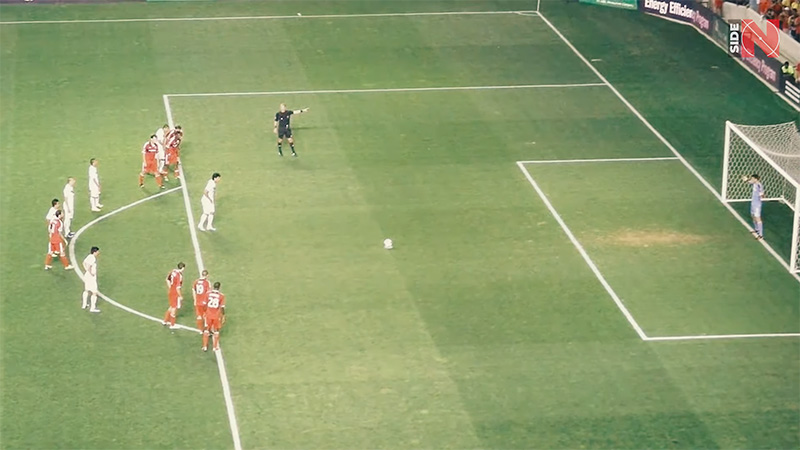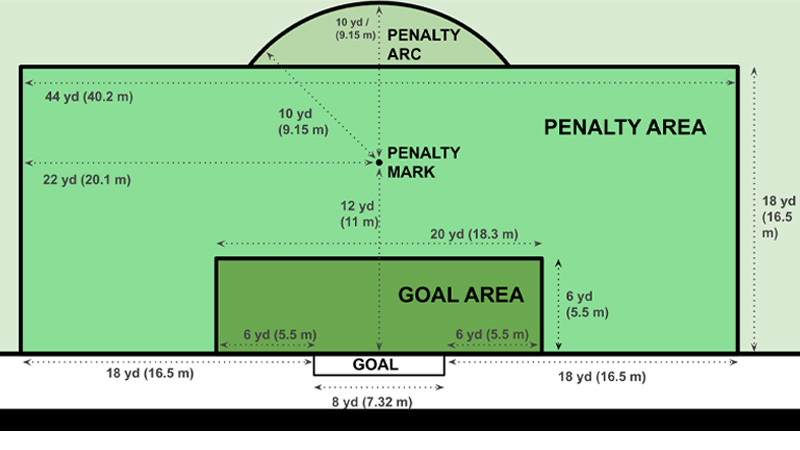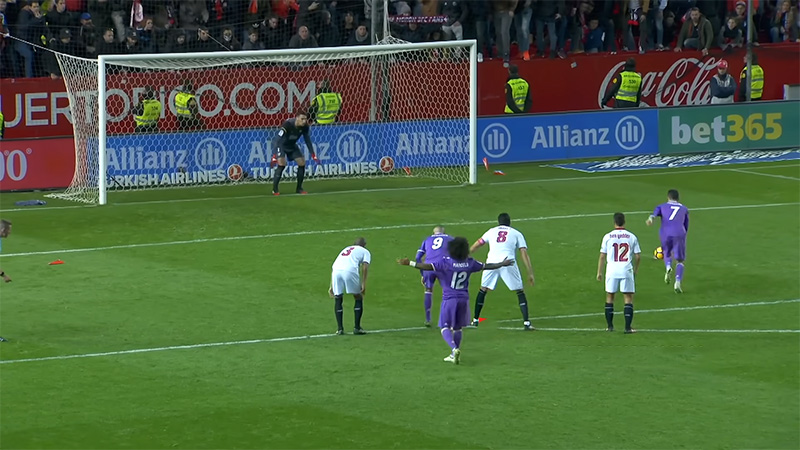In the dynamic world of soccer, the penalty box stands as a defining and strategically significant area on the field. Also known as the 18-yard box, this rectangular zone located in front of the goal serves as a crucial battleground where the fate of matches can be shaped.
Understanding what is considered the penalty box in soccer is fundamental for players, coaches, and fans alike, as it holds the key to crucial moments such as penalty kicks and defensive actions.
Within this 18-yard expanse, defenders and goalkeepers guard their territory with utmost determination while attackers seek to exploit any opportunities that arise.
As a defining feature of the sport, the penalty box symbolizes the essence of soccer’s competitiveness, drama, and precision.
What Is Considered The Penalty Box In Soccer?
The penalty box, also known as the 18-yard box or simply the box, is a critical area on the soccer field with distinct rules and significance.
Here’s a paragraph description of what is considered the penalty box in soccer:
Defensive Area
The penalty box is a rectangular area located in front of the goal at both ends of the soccer field. It stretches 18 yards (approximately 16.5 meters) from the goal line into the field and is 44 yards (approximately 40 meters) wide.
This area is the last line of defence for the goalkeeper and the defensive players, and it is where the most significant defensive actions take place, including blocking shots and clearing the ball from the danger zone.
Goalkeeper’s Territory
The penalty box is the exclusive territory of the goalkeeper when it comes to handling the ball with their hands.
Inside the box, the goalkeeper has the privilege of using their hands to catch, parry, or control the ball, providing vital support to the defensive line and enabling quick distribution to initiate counter-attacks.
Foul Consequences
Foul infractions committed by the defending team within the penalty box result in penalty kicks for the attacking team. When a foul, such as a handball or a reckless challenge, occurs inside the penalty box, the opposing team is awarded a penalty kick.
The ball is placed on the penalty spot, located 12 yards (approximately 11 meters) from the goal line and at the center of the penalty box, giving the attacking team a clear opportunity to score unopposed.
Set-Piece Significance
The penalty box is also a crucial area for set-piece strategies. During corner kicks and free kicks near the penalty box, teams aim to deliver precise crosses or direct shots toward this area, hoping to capitalize on goal-scoring opportunities through headers or well-placed shots on target.
Goalkeeper’s Dilemma
For goalkeepers, the penalty box presents a constant dilemma in decision-making. They must assess when to come off their goal line to intercept crosses or clear dangerous situations and when to stay on their line to make crucial saves.
The penalty box is an intense and high-pressure zone where goalkeepers’ skills and judgment are put to the test.
The penalty box in soccer is the rectangular area in front of the goal where defensive actions, goalkeeping prowess, and set-piece strategies converge.
It is a critical zone that can decide the outcome of matches, making it a focal point of drama and excitement on the soccer field.
How Large Is The Penalty Area In Soccer?

The penalty area, also known as the 18-yard box or simply the box, is a critical zone on the soccer field with specific dimensions that significantly impact the dynamics of the game.
Here’s a paragraph description of the size of the penalty area in soccer:
Rectangular Shape
The penalty area is a rectangular zone positioned in front of the goal at both ends of the soccer field. It is symmetrical in shape, forming a perfect rectangle that spans horizontally across the field.
18-Yard Length
The length of the penalty area measures 18 yards (approximately 16.5 meters) from the goal line.
Starting from the goal line, the penalty area extends into the field, creating an 18-yard distance that defensive players and the goalkeeper must protect.
Width of 44 Yards
The width of the penalty area is 44 yards (approximately 40 meters), spanning horizontally from one side to the other. This dimension allows sufficient space for players to manoeuvre and positions defenders to form a cohesive defensive wall in front of the goal.
Penalty Spot
At the center of the penalty area, precisely 12 yards (approximately 11 meters) from the goal line, lies the penalty spot. This spot is the designated location from which penalty kicks are taken.
It serves as the reference point for positioning the ball during penalty kicks, providing a standardized and consistent distance for all penalty takers.
Goalkeeper’s Territory
The penalty area is the exclusive territory of the goalkeeper when it comes to handling the ball with their hands.
Inside the box, the goalkeeper has the privilege of using their hands to catch, parry, or control the ball, providing vital support to the defensive line and enabling quick distribution to initiate counter-attacks.
The penalty area in soccer is a rectangular zone positioned in front of the goal, measuring 18 yards in length and 44 yards in width.
This critical zone is where penalty kicks are taken, and it is the exclusive territory for the goalkeeper to use their hands.
The penalty area’s dimensions play a significant role in shaping defensive strategies, set-piece scenarios, and the outcome of matches, making it a focal point of action and tension on the soccer field.
What Is The Difference Between A Penalty Box And A Goal Box?

Source: wikipedia
The terms “penalty box” and “goal box” are often used interchangeably in soccer, but they refer to different areas on the field with distinct purposes and functions.
Let’s explore the differences between the penalty box and the goal box in soccer:
Penalty Box
The penalty box, also known as the 18-yard box, is a rectangular area located in front of the goal at both ends of the soccer field.
It is marked by two parallel lines that extend 18 yards (approximately 16.5 meters) from the goal line into the field.
The penalty box serves primarily as a defensive zone, and it is a critical area for goalkeepers and defensive players to protect.
When a defending player commits a foul within the penalty box, the opposing team is awarded a penalty kick from the penalty spot, which is located at the centre of the penalty box.
Penalty kicks are a direct and unopposed attempt at goal, making the penalty box a high-stakes and decisive area on the field.
Goal Box
The goal box, also known as the six-yard box or the small box, is a smaller rectangular area within the penalty box. It is marked by two lines that extend 6 yards (approximately 5.5 meters) from the goal line into the field.
The goal box is situated closer to the goal than the penalty box, and its primary purpose is to define the area from which goal kicks are taken.
When the ball goes out of play beyond the goal line after last touching an attacking player, the defending team is awarded a goal kick. The goal kick is taken from anywhere within the goal box, allowing the defending team to restart play without opposition from the attacking team.
The penalty box is a larger rectangular area located in front of the goal, where penalty kicks are awarded for fouls committed by the defending team.
On the other hand, the goal box is a smaller rectangular area within the penalty box, designated for goal kicks to restart play after the ball goes out of play beyond the goal line.
Both areas are essential components of the soccer field, with the penalty box being a critical zone for defensive actions and penalty kicks, while the goal box is crucial for restarting play from the goal area.
FAQ
What is the penalty box in soccer?
Answer: The penalty box, also known as the 18-yard box, is a rectangular area located in front of the goal at both ends of the soccer field. It spans 18 yards (approximately 16.5 meters) from the goal line into the field and is 44 yards (approximately 40 meters) wide.
What is the purpose of the penalty box in soccer?
Answer: The penalty box serves multiple purposes in soccer. Defensively, it is a crucial area where goalkeepers and defensive players try to block shots and clear the ball from dangerous positions.
How is the penalty box different from the goal box?
Answer: The penalty box and the goal box are two distinct areas on the soccer field. The penalty box is a larger rectangular zone located in front of the goal, spanning 18 yards from the goal line into the field. It is primarily a defensive area where penalty kicks are awarded.
How is the penalty spot related to the penalty box?
Answer: The penalty spot is a critical element located within the penalty box. It is positioned 12 yards (approximately 11 meters) from the goal line and at the centre of the penalty box. The penalty spot is the designated location from which penalty kicks are taken.
What happens if a player commits a foul inside the penalty box?
Answer: If a defending player commits a foul inside the penalty box, the opposing team is awarded a penalty kick. The attacking team’s designated penalty taker must place the ball on the penalty spot within the penalty box. The goalkeeper and all other players, except for the penalty taker and the goalkeeper, must remain outside the penalty box until the ball is kicked.
Conclusion
The penalty box in soccer, synonymous with the 18-yard box, is much more than just a marked area on the field; it represents a realm of tension, excitement, and strategy.
Defenders strive to keep their goal protected, employing coordinated movements and defensive prowess, while goalkeepers stand as the last line of defence, ready to showcase their agility and reflexes.
On the other hand, attackers approach the penalty box with ambition, seeking to exploit any opportunity to draw fouls or create goal-scoring chances.
The penalty box is where penalty kicks are awarded, encapsulating the pressure and significance of these critical moments.
As the epicenter of defensive and attacking maneuvers, the penalty box symbolizes the heart and soul of soccer, showcasing the sport’s passion, skill, and drama on the grand stage of the pitch.







